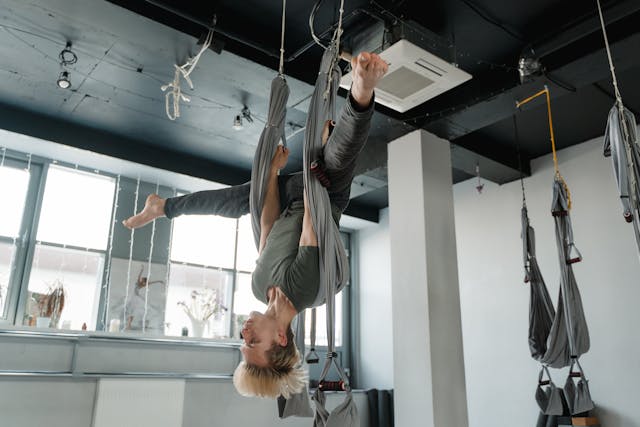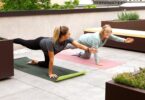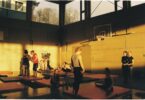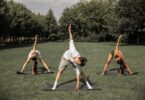Finding the perfect aerial yoga class near you can open up a whole new world of fitness and fun. If you’ve ever seen those stunning images of people gracefully suspended in mid-air and wondered what it’s all about, this article is for you. We’ll guide you through everything you need to know about aerial yoga, from its benefits to how to find the best classes in your area.
Table of Contents
What is Aerial Yoga?
Aerial yoga, also known as anti-gravity yoga, is a type of yoga that combines traditional yoga poses, Pilates, and dance with the use of a suspended hammock. This hammock supports your body, allowing you to achieve various poses that might be difficult on the ground. Originating in the early 2000s, aerial yoga has grown in popularity for its unique approach to fitness and flexibility.
Benefits of Aerial Yoga
Aerial yoga offers a myriad of benefits for both the body and mind:
Physical Benefits
- Enhanced Flexibility: The hammock allows for deeper stretches and helps increase your range of motion.
- Improved Strength: Many aerial yoga poses require you to engage your core and other muscle groups, leading to overall strength improvement.
- Spinal Decompression: Hanging upside down can help decompress your spine and relieve back pain.
Mental Health Benefits
- Stress Relief: The sensation of floating can be incredibly relaxing, helping to reduce stress and anxiety.
- Boosted Confidence: Mastering new poses and movements can enhance your self-esteem and confidence.
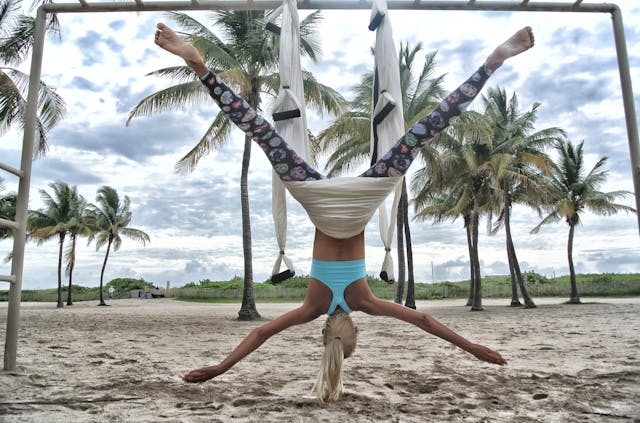
Types of Aerial Yoga Classes
Aerial yoga, also known as anti-gravity yoga, combines traditional yoga poses, Pilates, and dance with the use of a hammock or silk apparatus. This unique practice offers various types of classes, each with its own focus and benefits:
- Introductory Aerial Yoga:
- Designed for beginners.
- Focuses on basic poses and techniques.
- Teaches how to use the hammock safely and effectively.
- Aerial Flow Yoga:
- Combines aerial yoga poses with a flowing sequence.
- Emphasizes fluid transitions and synchronizing breath with movement.
- Suitable for those with some yoga or aerial experience.
- Aerial Restorative Yoga:
- Focuses on relaxation and gentle stretching.
- Utilizes the hammock for support in restorative poses.
- Aims to reduce stress and promote deep relaxation.
- Aerial Fitness Yoga:
- Incorporates strength training and cardio elements.
- Includes more dynamic movements and inversions.
- Targets overall fitness, improving strength, flexibility, and endurance.
- Aerial Dance Yoga:
- Blends dance movements with aerial yoga poses.
- Emphasizes grace, balance, and artistic expression.
- Suitable for those interested in dance and performance aspects.
- Aerial Yoga for Kids:
- Tailored specifically for children.
- Focuses on fun, playful movements and simple poses.
- Helps improve coordination, flexibility, and confidence.
- Aerial Therapeutic Yoga:
- Designed for individuals with specific health conditions or physical limitations.
- Focuses on gentle, supportive movements to aid in rehabilitation and healing.
- Often conducted in small groups or private sessions.
- Advanced Aerial Yoga:
- For experienced practitioners.
- Includes complex poses, advanced inversions, and transitions.
- Requires strong core strength, flexibility, and aerial skills.
Specialty Classes: Include prenatal aerial yoga for expecting mothers or classes designed specifically for children.
How to Find Aerial Yoga Classes Near You
Finding aerial yoga classes near you can be an exciting journey. Here are some steps to help you locate the best classes in your area:
- Search Online:
- Use search engines like Google to find aerial yoga studios and classes in your vicinity. Keywords like “aerial yoga classes near me” or “anti-gravity yoga classes ” can be helpful.
- Check online directories like Yelp, ClassPass, and MindBody for listings and reviews of local studios.
- Visit Local Yoga Studios:
- Many traditional yoga studios offer aerial yoga classes. Visit or call nearby studios to inquire about their class schedules and offerings.
- Ask for a trial class or tour to get a feel for the environment and teaching style.
- Use Social Media:
- Platforms like Facebook, Instagram, and Twitter are great for finding local aerial yoga communities. Search for aerial yoga groups, pages, and hashtags specific to your location.
- Join local fitness or yoga groups where members often share recommendations and experiences.
- Check Community Centers and Gyms:
- Some community centers and gyms offer aerial yoga classes as part of their fitness programs. Check their websites or visit in person to find out more.
- Look for flyers or bulletin board announcements about upcoming classes.
- Ask for Recommendations:
- Reach out to friends, family, or coworkers who practice yoga. They might know of good aerial yoga classes in the area.
- Ask for recommendations on online forums or local community boards like Nextdoor or Reddit.
- Attend Yoga and Fitness Events:
- Look for yoga festivals, health fairs, or fitness expos in your area. These events often feature aerial yoga demonstrations and offer information about local classes.
- Network with instructors and fellow attendees to discover new classes and studios.
- Download Fitness Apps:
- Apps like ClassPass, MindBody, and Zenrez allow you to search for and book aerial yoga classes in your area.
- These apps often provide user reviews and ratings, helping you choose the best classes.
- Visit Studio Websites:
- Many aerial yoga studios have detailed websites with information on class schedules, pricing, and instructor bios.
- Sign up for newsletters or follow their social media pages to stay updated on new classes and special offers.
Ask about class sizes, instructor qualifications, and whether they offer beginner-friendly options. It’s also helpful to inquire about the studio’s cancellation policy and any introductory offers.
What to Expect in Your First Aerial Yoga Class
Embarking on your first aerial yoga class can be an exciting and somewhat intimidating experience. Here’s a guide to help you know what to expect and how to prepare:
1. Preparation Before Class
- Attire: Wear comfortable, form-fitting clothes that cover your legs and armpits to prevent skin irritation from the hammock. Avoid loose clothing that can get tangled.
- Hydration and Nutrition: Stay hydrated and eat a light meal 1-2 hours before class to ensure you have energy without feeling too full.
- Arrival Time: Arrive at least 10-15 minutes early to sign in, get acquainted with the studio, and meet the instructor.
2. Class Introduction
- Instructor Briefing: The instructor will typically give a brief introduction to aerial yoga, including the benefits, safety precautions, and how to use the hammock.
- Equipment Setup: You’ll be shown how to adjust the height of your hammock to ensure it’s at the right level for various poses.
3. Warm-Up
- Gentle Stretching: The class will start with a series of ground-based warm-up exercises to prepare your body for the movements ahead.
- Hammock Familiarization: You’ll learn basic grips, wraps, and how to sit in the hammock.
4. Learning Basic Poses
- Standing Poses: You’ll begin with standing poses that incorporate the hammock for support, such as supported lunges and squats.
- Seated and Reclined Poses: These may include poses like the hammock-assisted bridge or seated spinal twists.
- Inversions: For those comfortable, the instructor might introduce beginner-friendly inversions, such as the “cocoon” pose, where you’re wrapped comfortably in the hammock.
5. Flow and Transitions
- Connecting Poses: The class will often include sequences where you transition smoothly from one pose to another, using the hammock for support and balance.
- Focus on Breath: Synchronizing breath with movement is emphasized to help you stay relaxed and centered.
6. Core and Strength Work
- Strengthening Exercises: Some classes incorporate exercises that focus on building core strength, such as aerial planks or leg lifts.
- Balance Challenges: You may practice balancing poses that test and improve your stability and coordination.
7. Cool Down and Relaxation
- Stretching: The class will end with gentle stretching exercises to cool down your muscles.
- Savasana in the Hammock: You’ll experience a relaxing savasana (final relaxation) while lying in the hammock, often referred to as “floating savasana.”
8. Post-Class Routine
- Hydration: Drink water to rehydrate and help with muscle recovery.
- Feedback: Feel free to ask the instructor any questions or share feedback about your experience.
9. Common Tips
- Listen to Your Body: Go at your own pace and don’t push yourself too hard. Aerial yoga is about finding a balance between challenge and comfort.
- Ask for Help: If you’re unsure about a pose or movement, don’t hesitate to ask the instructor for assistance or modifications.
- Enjoy the Experience: Remember to have fun and enjoy the unique sensation of moving and stretching in the air.
Preparing for Your First Class
Proper preparation can enhance your aerial yoga experience:
What to Wear
Opt for form-fitting clothing that covers your legs and arms to prevent hammock burns. Avoid jewelry and loose clothing that can get caught in the hammock.
What to Bring
Bring a water bottle, a towel, and an open mind. Some studios may provide mats, but it’s always good to check in advance.
Mental Preparation
Approach your first class with an open and positive mindset. Aerial yoga can be challenging, but it’s also a lot of fun!
Aerial Yoga Equipment
Aerial yoga requires specific equipment to ensure a safe and effective practice. Here’s an overview of the essential gear you’ll need:
1. Aerial Yoga Hammock
- Material: Made from high-density nylon or silk, designed to support your body weight.
- Size: Typically 5-6 meters long to accommodate various poses and adjustments.
- Weight Capacity: Ensure the hammock can support at least 400-600 pounds for safety.
2. Rigging Equipment
- Ceiling Mounts: Secure anchors attached to the ceiling are usually installed by professionals.
- Carabiners: Strong metal clips that connect the hammock to the ceiling mounts.
- Daisy Chains: Adjustable straps that allow you to change the height of the hammock easily.
3. Supportive Gear
- Crash Mats: Thick, cushioned mats placed under the hammock to provide extra safety during inversions and falls.
- Yoga Blocks: These are used to assist in poses and provide additional support where needed.
4. Clothing and Accessories
- Appropriate Attire: Form-fitting clothing that covers the legs and armpits to prevent skin irritation and improve grip.
- No Jewelry: Remove all jewelry to prevent snagging on the hammock.
5. Yoga Mat
- Ground Support: Placed under the hammock for additional comfort and support during ground-based poses and warm-ups.
6. Maintenance Tools
- Cleaning Supplies: Mild detergent and a soft cloth for regular cleaning of the hammock.
- Inspection Kit: Tools to regularly check the integrity of the rigging equipment and hammock fabric for wear and tear.
7. Optional Add-Ons
- Grip Aids: Chalk or grip-enhancing products to improve hand and foot traction on the hammock.
- Resistance Bands: Used in combination with the hammock for added strength training exercises.
- Eye Pillow or Blanket: For added comfort during relaxation poses or savasana in the hammock.
Key Points for Safety and Maintenance
- Regular Inspections: Check all equipment regularly for signs of wear, including the hammock, carabiners, and ceiling mounts.
- Professional Installation: Ensure that ceiling mounts and rigging are installed by professionals to prevent accidents.
- Weight Limits: Always adhere to the weight limits specified by the equipment manufacturers.
FAQs
Is Aerial Yoga Good for Beginners?
Yes, aerial yoga can be good for beginners, provided the class is designed for novices, and the instructor is experienced in guiding new students. Here’s why it can be beneficial:
Support and Alignment: The hammock provides support, helping beginners achieve proper alignment and explore poses they might find challenging on the ground.
Reduced Joint Pressure: The support of the hammock can reduce strain on joints, making it easier for beginners to engage in yoga poses without discomfort.
Improved Flexibility and Strength: Aerial yoga can enhance flexibility and strength, which are foundational elements for more advanced yoga practices.
Where to Try Aerial Yoga?
To find aerial yoga classes, consider these options:
Local Yoga Studios: Many yoga studios offer aerial yoga classes. Check their schedules and class descriptions to find beginner-friendly options.
Fitness Centers and Gyms: Some gyms and fitness centers include aerial yoga in their class offerings.
Community Centers: Local community centers or recreational facilities might have aerial yoga classes.
Specialized Aerial Yoga Studios: Studios dedicated to aerial and anti-gravity yoga will have the equipment and expertise for a comprehensive experience.
Online Platforms: For those who prefer at-home practice, online platforms like YouTube or subscription-based services offer aerial yoga tutorials and classes. Ensure you have the proper setup and equipment if practicing at home.
Is Aerial Yoga Harder Than Yoga?
The difficulty of aerial yoga compared to traditional yoga depends on several factors:
Support vs. Challenge: The hammock can provide support, making some poses easier, but it can also introduce new challenges, especially with balance and coordination.
Type of Class: Beginner aerial yoga classes are designed to be accessible, while advanced classes can be quite demanding.
Individual Fitness Level: Your personal fitness level and familiarity with yoga will influence how challenging you find aerial yoga.
Is Aerial Yoga Better Than Pilates?
Aerial yoga and Pilates offer different benefits, and one is not necessarily better than the other. It depends on your goals and preferences:
Aerial Yoga:
Focuses on flexibility, strength, and alignment using the hammock.
Incorporates elements of traditional yoga, Pilates, and dance.
Offers a unique experience of moving in and out of poses while suspended.
Pilates:
Emphasizes core strength, stability, and overall body conditioning.
Often uses equipment like the Reformer, which provides resistance and support.
Focuses on precise movements and controlled breathing.
Comparison:
Flexibility and Stretching: Aerial yoga might offer more opportunities for deep stretching due to the support of the hammock.
Core Strength: Both aerial yoga and Pilates are excellent for building core strength, but Pilates has a more targeted approach.
Experience: Aerial yoga provides a unique experience of being suspended, which can be exciting and fun, while Pilates offers a more grounded and controlled workout.
Conclusion
Aerial yoga offers a unique and enjoyable way to improve your physical and mental health. With numerous benefits and a growing number of classes available, now is the perfect time to give it a try. Remember, the key to success is finding the right class and instructor for you. So, take the leap and start your aerial yoga journey today!

